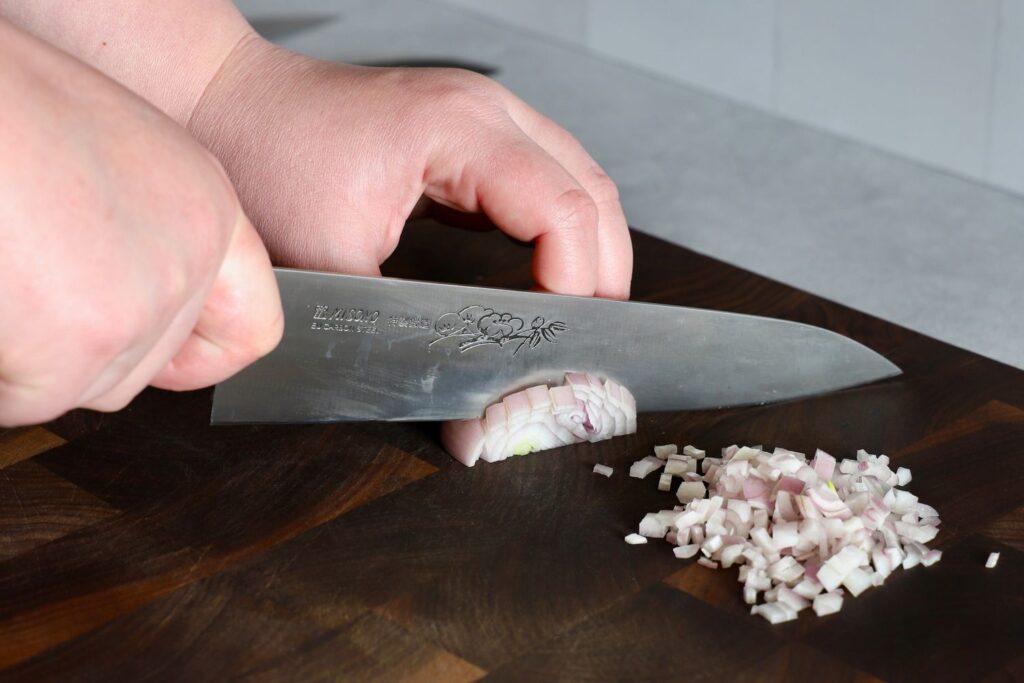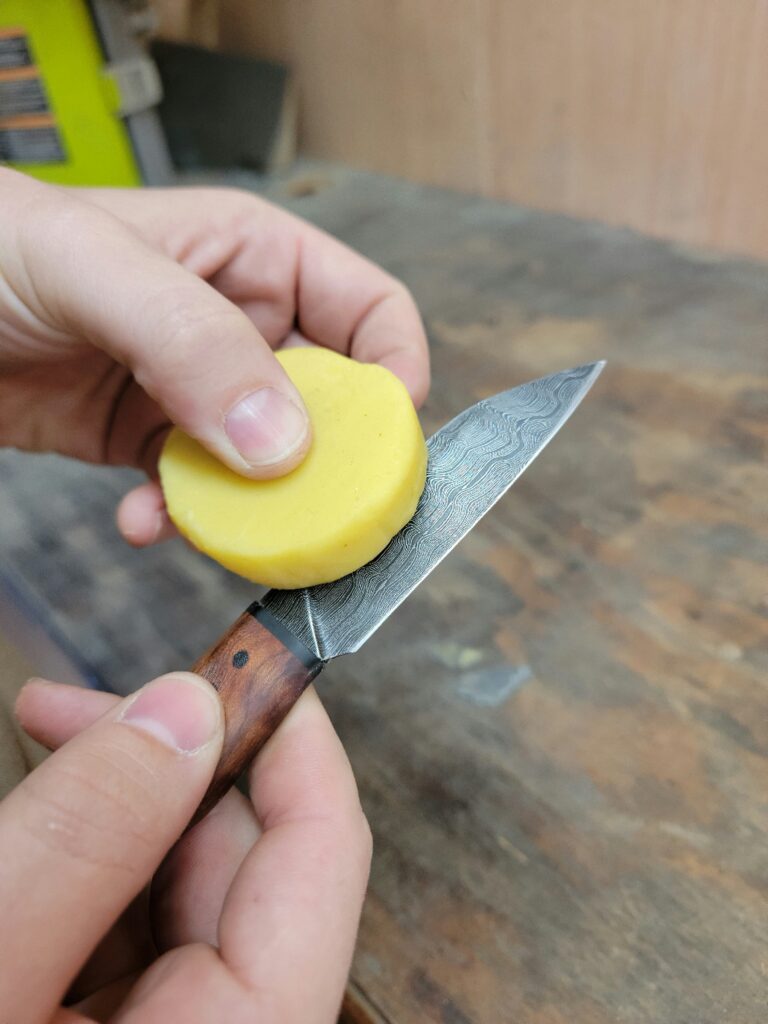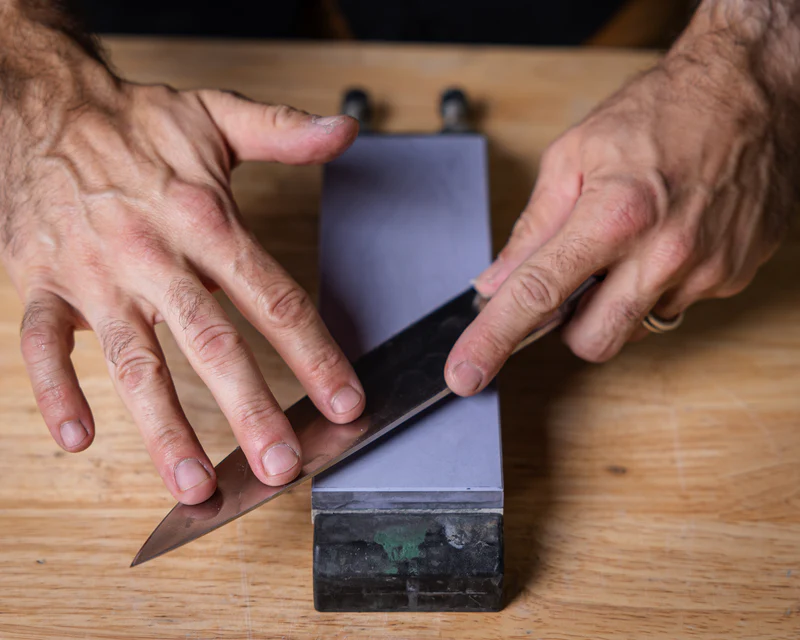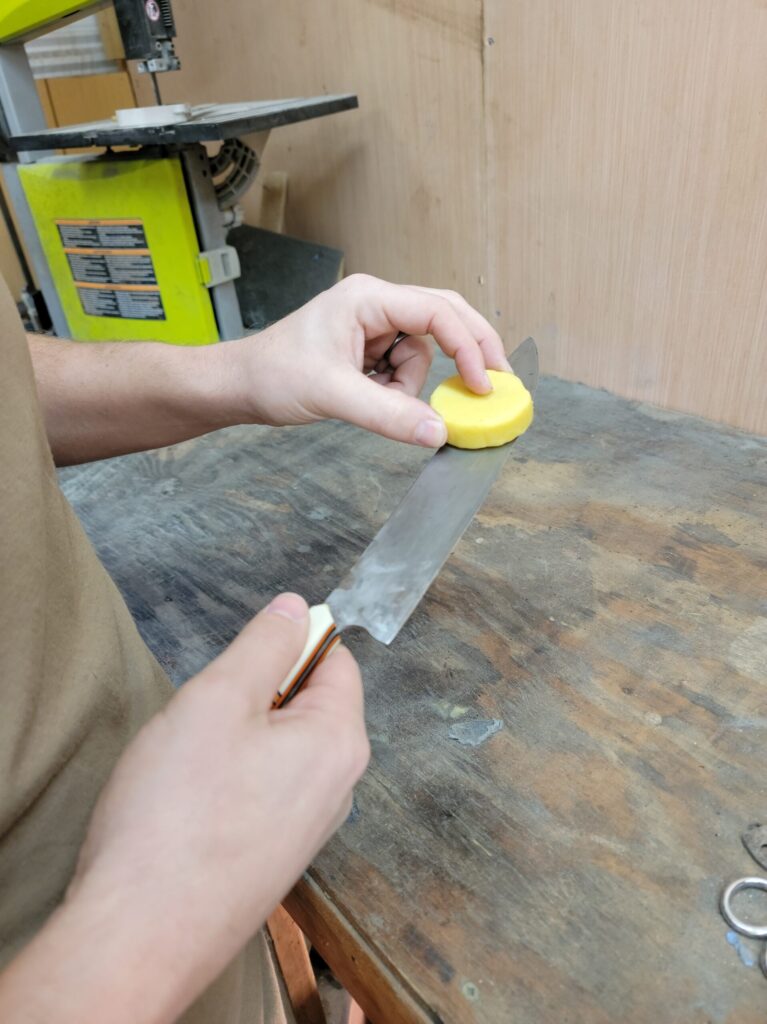TLDR: Mastering Carbon Knife Care
Want to keep your carbon steel knives sharp and rust-free? Here are essential tips for maintaining peak performance and longevity:
- Carbon steel knives offer superior sharpness and edge retention but are prone to rust and discoloration without proper care.
- Regular cleaning, immediate drying, and applying food-safe mineral oil help prevent rust and preserve the blade.
- Use sharpening stones and honing rods to maintain a sharp edge, with proper technique to avoid damage.
- Storing knives in a dry place, such as a knife block or magnetic strip, protects the blade from environmental damage.
- Avoid common mistakes like improper drying, using the wrong cutting surfaces, and neglecting professional sharpening when needed.
Want a carbon steel knife but feel intimidated by them? Or do you own a carbon steel knife, yet don’t really know how to keep it from rusting? Mastering your carbon knife care is essential for both longevity and peak performance. Unlike stainless steel alternatives, carbon knives boast unparalleled sharpness and edge retention, making them a favorite among professional chefs and home cooks alike. However, their unique composition requires specific care to prevent rust and maintain that razor-sharp edge. In this guide, we’ll explore essential tips to help you nurture your prized culinary tools—transforming them into lifelong companions in your kitchen adventures. From proper cleaning techniques to storage solutions, each recommendation is designed to enhance your knife’s performance and durability. Get ready to unlock the full potential of your carbon knives and make every slice, dice, and chop a celebration of skill and craftsmanship!
Understanding Carbon Steel Knives: What’s the fuss about?
Carbon steel knives stand out in the culinary world for their exceptional performance and unique characteristics. Unlike stainless steel knives, which contain chromium to prevent rust, carbon steel knives are composed primarily of iron and carbon. This composition allows for a finer grain structure, which means that carbon steel blades can be honed to a much sharper edge. Chefs and cooking enthusiasts appreciate the precision and control that a sharp carbon steel knife affords, making it an indispensable tool in the kitchen.

The sharpness of carbon steel knives is not their only appealing feature. These knives also excel in edge retention, meaning they stay sharp for longer periods compared to their stainless steel counterparts. This is due to the hardness of the carbon steel, which resists wear from cutting and chopping. As a result, less frequent sharpening is required, which in turn prolongs the life of the blade. The ability to maintain a razor-sharp edge is particularly essential for tasks that demand precision, such as slicing delicate vegetables or filleting fish.
However, the very properties that make carbon steel knives so desirable also present certain challenges. The absence of chromium, which is what prevents rust in stainless steel, means that carbon steel is more prone to oxidation. Without proper care, these knives can quickly develop rust and discoloration. This vulnerability necessitates a dedicated approach to maintenance, ensuring that the knife not only performs at its best but also has a long, functional life. Understanding these unique aspects of carbon steel knives is the first step toward mastering their care.
If you would like to learn how to make a knife yourself, you can learn more here.
Proper Knife Care: How important is it?
Proper knife care is crucial for a number of reasons, not least of which is the preservation of the blade’s integrity. A well-maintained knife ensures safety in the kitchen, as a sharp, clean blade is less likely to slip and cause injury. Dull or rusted knives force the user to apply more pressure when cutting, increasing the risk of accidents. Therefore, keeping your carbon steel knife in top condition is not only about performance but also about safety.
Moreover, regular maintenance of your carbon steel knife helps in retaining its aesthetic appeal. Carbon steel knives are known for developing a patina over time—a natural protective layer that can give the blade a unique, almost artistic appearance. This patina acts as a barrier against rust and corrosion, much like the seasoning on a cast-iron skillet. However, achieving and maintaining this patina requires consistent care and attention. Neglecting your knife can lead to unsightly rust spots that are difficult to remove and can compromise the blade’s functionality.
In addition to safety and aesthetics, proper knife care contributes to the overall efficiency of your kitchen operations. A well-maintained knife performs better, making food preparation quicker and more enjoyable. Whether you’re a professional chef working in a high-pressure environment or a home cook preparing meals for your family, the efficiency gained from a sharp, well-cared-for knife is invaluable. Investing time in regular maintenance helps you get the most out of your carbon steel knife, ensuring it remains a reliable companion in your culinary endeavors.
Essential Tools for Carbon Knife Maintenance
Maintaining a carbon steel knife requires a set of essential tools designed to address its specific needs. One of the most important tools in your maintenance arsenal is a high-quality sharpening stone. Often referred to as whetstones, these stones come in various grits, each suited for different stages of sharpening. Coarse grit stones are used for repairing chips and setting a new edge, while finer grits are ideal for honing and polishing the blade to a razor-sharp finish. Owning a range of grits allows you to perform comprehensive sharpening, ensuring your carbon steel knife remains in peak condition.
In addition to sharpening stones, a honing rod is a valuable tool for maintaining the edge of your knife between sharpening sessions. Honing rods, typically made of steel or ceramic, help to realign the microscopic teeth along the blade’s edge that can become misaligned with regular use. Regular honing can extend the periods between more intensive sharpening sessions, preserving the blade’s integrity and performance. It’s important to choose a honing rod that complements the hardness of your carbon steel knife to avoid causing damage to the blade.
Other essential tools for carbon knife maintenance include a soft cloth for wiping the blade clean, food-safe wax or mineral oil for preventing rust, and a non-abrasive scrubber for removing any stubborn residues. A dedicated knife block or magnetic strip for storage can also help protect the blade from unnecessary wear and tear. Each of these tools plays a specific role in the care and upkeep of your carbon steel knife, contributing to its longevity and ensuring it remains a joy to use in the kitchen.

Cleaning Your Carbon Knife: Best Practices
Cleaning your carbon steel knife properly is paramount to preventing rust and maintaining its pristine condition. After each use, it’s essential to clean the knife promptly to remove any food particles that could cause staining or corrosion. Begin by rinsing the blade under warm water, using a soft sponge or cloth to gently wipe away any debris. Avoid using abrasive scrubbers or harsh detergents, as these can damage the blade’s surface and strip away the protective patina.
Once the knife is clean, it’s crucial to dry it immediately and thoroughly. Leaving a carbon steel knife wet or even slightly damp can lead to rust formation in a matter of hours. Use a soft, absorbent towel to dry the blade, taking care to remove any moisture from the handle as well. For added protection, you can apply a thin layer of food-safe mineral oil to the blade before storing it. This oil acts as a moisture barrier, further safeguarding the knife against rust.
It’s also important to note that carbon steel knives should never be placed in a dishwasher. The high temperatures and harsh detergents used in dishwashers can cause significant damage to the blade and handle. Additionally, the prolonged exposure to water can lead to rust and other forms of corrosion. Hand-washing your knife with care not only preserves its functionality but also enhances its longevity, ensuring it remains a valuable tool in your kitchen for years to come.
Sharpening Techniques for Optimal Performance
Sharpening your carbon steel knife is both an art and a science, requiring a precise technique to achieve the best results. Begin by selecting the appropriate grit on your whetstone. If your knife is significantly dull or has minor chips, start with a coarse grit to re-establish the edge. Submerge the whetstone in water for about 10-15 minutes before use, ensuring it is fully saturated. Place the stone on a stable surface, ready for the sharpening process.

Hold the knife at a consistent angle—typically between 15 to 20 degrees—against the whetstone. This angle is crucial for creating a sharp edge without weakening the blade. Using even pressure, slide the knife along the stone in a sweeping motion, ensuring that the entire length of the blade makes contact with the stone. Repeat this process several times on each side of the blade, maintaining the angle and pressure throughout. As you progress, move to finer grit stones to hone and polish the edge, achieving a razor-sharp finish.
Once the knife is sharpened, it’s beneficial to use a honing rod to refine the edge further. Holding the rod vertically, swipe the knife blade against it at the same angle used during sharpening. This process helps to get rid of the burr that was developed along the edge, enhancing its sharpness and longevity. Regular honing, combined with periodic sharpening, ensures that your carbon steel knife remains in optimal condition, ready to tackle any culinary task with precision and ease.
Preventing Rust and Corrosion on Carbon Knives
Preventing rust and corrosion on carbon steel knives is a critical aspect of their maintenance. One of the most effective ways to protect your knife is by developing a patina on the blade. This patina, a layer of oxidation, acts as a barrier against rust while giving the knife a distinctive, personalized appearance. You can encourage the formation of a patina by using the knife to cut acidic foods like tomatoes, onions, and citrus fruits. Over time, the patina will darken and become more protective.
In addition to encouraging a patina, regular oiling of the blade is essential for preventing rust. After cleaning and drying your knife, apply a thin layer of food-safe mineral oil to the blade. This oil creates a moisture-resistant barrier, protecting the knife from oxidation. Be sure to reapply the oil periodically, especially if the knife has been heavily used or washed. Proper oiling not only prevents rust but also helps maintain the blade’s sharpness and overall condition.

It’s also important to store your carbon steel knife in a dry environment. Avoid leaving the knife in damp or humid areas, as this can accelerate rust formation. Using a knife block, magnetic strip, or protective sheath can help protect the blade from moisture and other environmental factors. By taking these preventative measures, you can ensure that your carbon steel knife remains free from rust and corrosion, preserving its performance and extending its lifespan.
Proper Storage Solutions for Carbon Knives
Proper storage is a key component of carbon knife care, crucial for maintaining the blade’s integrity and ensuring safety in the kitchen. One of the best storage solutions is a dedicated knife block. Knife blocks protect the blade from accidental damage, keeping it sharp and ready for use. When placing the knife in the block, ensure that the blade is clean and dry to prevent any moisture buildup that could lead to rust. Knife blocks also offer the convenience of keeping your knives organized and easily accessible.
Magnetic knife strips are another excellent storage option. These strips hold the knife securely in place, allowing the blade to air dry and remain visible. This storage method not only saves counter space but also adds a modern aesthetic to your kitchen. However, it’s important to choose a magnetic strip with a strong, even hold to prevent the knife from slipping or falling. Additionally, position the strip away from areas with high humidity, such as near the sink, to further protect the blade from moisture.
Protective sheaths or blade guards offer a portable and versatile storage solution. These covers shield the blade from physical damage and prevent accidental cuts when reaching into a drawer. Sheaths are particularly useful for transporting knives or when space is limited. Ensure that the sheath fits snugly around the blade and is free from any moisture and/or debris that could scratch the surface. Proper storage solutions not only protect your carbon steel knife but also enhance its longevity and performance, making it a reliable tool in your culinary endeavors.
Common Mistakes to Avoid in Knife Care
When it comes to caring for your carbon steel knife, there are several common mistakes that can significantly impact its performance and longevity. One of the most frequent errors is neglecting to dry the knife thoroughly after washing. Even a small amount of residual moisture can lead to rust formation, compromising the blade’s integrity. Always take the time to dry your knife completely with a soft, absorbent towel to prevent this issue.
Another mistake is using the wrong cutting surface. Hard surfaces like glass, marble, or ceramic can quickly dull the blade and cause chips or other damage. Instead, opt for softer materials such as wood or plastic when cutting. These surfaces provide a gentle cushion for the blade, helping to maintain its sharpness and prevent unnecessary wear. Regularly checking your cutting boards for deep grooves or cracks is also important, as these can harbor bacteria and damage the knife.
Improper sharpening techniques are another common pitfall. Using an incorrect angle, applying too much pressure, or using a low-quality sharpening tool can all lead to a poorly sharpened blade or even damage the knife. Take the time to learn proper sharpening methods and invest in high-quality tools to ensure your knife remains in optimal condition. Avoiding these common mistakes will help you get the most out of your carbon steel knife, ensuring it remains a valuable asset in your kitchen.
Signs Your Carbon Knife Needs Professional Attention
While regular maintenance can keep your carbon steel knife in good condition, there are times when professional attention is necessary. One of the most obvious signs that your knife needs expert care is significant dullness. If you’ve tried sharpening the blade yourself and it still struggles to cut through food efficiently, it may require professional sharpening to restore its edge. Professional sharpeners use specialized equipment and techniques to achieve a level of sharpness that is difficult to replicate at home.
Another indication that your knife needs professional care is the presence of chips or cracks in the blade. These imperfections can affect the knife’s performance and pose a safety risk. Attempting to repair a damaged blade on your own can lead to further issues, so it’s best to seek the expertise of a professional who can properly assess and address the damage. Professionals can also handle more complex repairs, such as re-tipping a broken point or re-grinding the blade to its original shape.
If you notice persistent rust or corrosion that you are unable to remove through regular cleaning and maintenance, it’s time to consult a professional. They have the tools and knowledge to safely remove rust without damaging the blade, as well as techniques to help prevent future corrosion. Regularly inspecting your knife for these signs and seeking professional attention when needed will help ensure your carbon steel knife remains in peak condition, ready for any culinary challenge.
Odds are, you have a professional knife maker or sharpener near you who will be more than willing to help with your maintenance if needed.
Conclusion: Embracing the Art of Carbon Knife Care
Mastering the care of your carbon steel knife is an investment in its longevity and performance. By understanding the unique properties of carbon steel and the importance of proper maintenance, you can keep your knife in excellent condition. Essential tools like sharpening stones, honing rods, and mineral oil play a crucial role in this process, while best practices in cleaning and storage further protect the blade.
Avoiding common mistakes and knowing when to seek professional care are also key to maintaining your knife’s functionality and safety. By following these guidelines, you can enjoy the unparalleled sharpness and precision that carbon steel knives offer, making every culinary task a pleasure. Embrace the art of carbon knife care and transform your knife into a lifelong companion in your kitchen adventures.
With dedication and the right techniques, your carbon steel knife can become an invaluable tool, enhancing your cooking experience and allowing you to showcase your culinary skills. By taking the time to care for your knife properly, you ensure that it remains a reliable and cherished part of your kitchen for years to come.
FAQ: Carbon Knife Care
Q: What makes high carbon steel knives different from stainless steel?
A: High carbon steel knives are known for their exceptional sharpness and edge retention. Unlike stainless steel, they don’t contain chromium, which means they’re more prone to rust but offer superior performance when maintained properly.
Q: How often should I perform knife care for a high carbon steel blade?
A: Ideally, you should clean and dry your knife after every use, oil it regularly, and sharpen or hone it as needed. Consistent knife care ensures your blade stays sharp, rust-free, and long-lasting.
Q: Can I use any oil or wax on my high carbon knife?
A: It’s important to use food-safe products. For rust prevention and long-term high carbon care, a quality knife wax can offer superior protection. Pelican Paste Wax is a great choice—it’s food-safe, easy to apply, and forms a durable barrier against moisture and oxidation.
Q: Is a patina good or bad for high carbon knives?
A: A patina is actually beneficial—it’s a natural layer of oxidation that helps protect your knife from rust. It gives your blade a unique look while aiding in high carbon steel maintenance.
Q: How do I store my carbon steel knife to prevent damage?
A: Always store your knife in a dry environment. Use a knife block, magnetic strip, or sheath, and avoid damp areas like near the sink. Before storage, apply a light coat of knife wax like Pelican Paste Wax to shield the blade from moisture.

